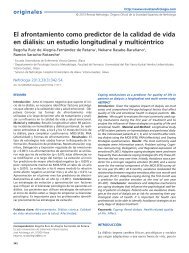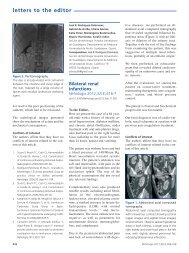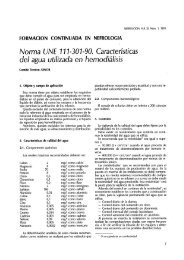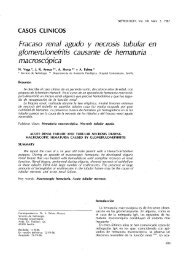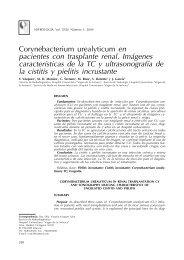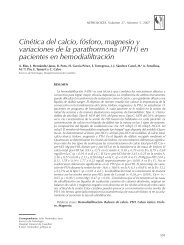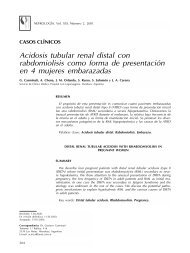PDF Número - NefrologÃa
PDF Número - NefrologÃa
PDF Número - NefrologÃa
Create successful ePaper yourself
Turn your PDF publications into a flip-book with our unique Google optimized e-Paper software.
Marcin Adamczak et al. Ischemic nephropathy<br />
revisión corta<br />
the renal parenchyma beyond the level of renal<br />
autoregulation.<br />
In patients with CKD stage 5 caused by ischemic<br />
nephropathy, survival during renal replacement therapy is<br />
also poor. Mailloux et al. observed a 25-months median<br />
survival and 18% 5 years survival rate in hemodialysis<br />
patients suffered from ischemic nephropathy which was<br />
significantly lower than 133 months median and 77% 5<br />
years survival in hemodialysis patients with polycystic<br />
kidney disease. 8<br />
EPIDEMIOLOGY<br />
The exact prevalence of ischemic nephropathy is difficult to<br />
estimate. The disease is often asymptomatic and few patients<br />
are screened unless they have clinical symptoms. Moreover,<br />
there are no precise, clinically useful and widely accepted<br />
diagnostic criteria of ischemic nephropathy.<br />
Therefore, the percentage of patients who develop CKD<br />
stage 5 due to ischemic nephropathy is difficult to assess.<br />
Scoble et al. performed renal arteriography in all patients<br />
entering the hemodialysis programme. 9 Ischemic<br />
nephropathy as a cause of terminal CKD was found in 6% of<br />
the entire group of patients. 8 However, among patients older<br />
than 50 years ischemic nephropathy as a cause CKD stage 5<br />
was observed in 14%. 9 In the other studies ischemic<br />
nephropathy was diagnosed as a cause of CKD stage 5 in<br />
11% and in 27% of patients respectively. 10,11 Mailloux et al.<br />
in one centre study identified ischemic nephropathy as a<br />
cause of CKD stage 5 in 12.2% of patients entering the<br />
hemodialysis programme. 12 In this study, ischemic<br />
nephropathy was the third greatest cause of CKD stage 5<br />
after diabetes mellitus and chronic glomerulonephritis. Using<br />
the data from the United States Renal Data System, Fatica et<br />
al. reviewed the primary causes of CKD stage 5 and found<br />
that the incidence of ischemic nephropathy causing CKD<br />
stage 5 increased from 1.4% in 1991 to 2.1% per year in<br />
1997. 13 The risk of CKD stage 5 from ischemic nephropathy<br />
versus CKD stage 5 from other causes was positively<br />
correlated with the age of these patients and was higher in<br />
males. Result of this analysis may suggest that the<br />
prevalence of ischemic nephropathy is increasing during the<br />
recent years, especially among older, male individuals.<br />
PATHOLOGY<br />
The main macroscopic feature of ischemic nephropathy is<br />
the reduction of kidney size. In a study by Dean et al. a<br />
decreased kidney size over 10% was noted on serial<br />
intravenous pyelograms in 37% of RAS patients. 14 Schreiber<br />
et al. examined in the retrospective study kidney length<br />
changes that were associated with arteriographic progression<br />
Nefrologia 2012;32(4):432-38<br />
of RAS. 15 Decrease in kidney size was defined as a >1.5cm<br />
difference in pole-to-pole measurements on serial x-ray<br />
pictures. Forty four percent of patients with atherosclerotic<br />
RAS have demonstrated the disease progression and 70% of<br />
these patients showed significant decrease of kidney size. 15<br />
Caps et al. showed the reduction of kidney size during two<br />
years observation period in 20.8% kidneys with >_60%<br />
RAS. 16<br />
It is not completely clear whether reduced kidney size<br />
always indicates irreversible parenchymal changes. In the<br />
histology of ischemic nephropathy both reversible tubular<br />
atrophy and glomerular collapse and irreversible<br />
glomerulosclerosis and interstitial fibrosis are present.<br />
Therefore, only result of renal biopsy is able to distinguish<br />
between the above mentioned causes of kidney atrophy, but<br />
it is rarely done in these settings because of the procedural<br />
risk of complications and no clear therapeutic implications.<br />
The earliest and the most pronounced histopathologic feature<br />
of the ischemic nephropathy are tubulointerstitial lesions. 17,18<br />
In 62 patients with RAS who underwent nephrectomy of a<br />
small kidney for uncontrolled hypertension, the predominant<br />
pattern of injury was significant tubulointerstitial atrophy<br />
with relative glomerular sparing. 19 Tubuloinsterstitial lesions<br />
may mediate the CKD progression towards irreversible<br />
damage. At the early phase of this process, cellular activation<br />
takes place, as mononuclear cells migrate into the<br />
interstitium and myofibroblasts release inflammatory<br />
mediators that lead to inflammation. 20 Apoptosis induces<br />
tubular atrophy which also occurred in patients with<br />
ischemic nephropathy. 21 This phase of disease may still be<br />
partly reversible until fibrosis begins. 22 Subsequent fibrosis<br />
leads to the kidney permanent damage.<br />
Glomerulosclerosis is a late event in patients with<br />
ischemic nephropathy. Glomerular lesions are initially<br />
minimal in experimental animals with chronic ischemic<br />
nephropathy and observed only when severe stenosis is<br />
present. 17,19,23,24 In some patients glomerular collapse with<br />
loss of tuft volume due to hypoperfusion is observed.<br />
Moreover fibrosis in the interstitial tissue in the vicinity of<br />
Bowman capsule of glomerulus can obstruct the origin of<br />
proximal tubuli and may lead to development of atubular,<br />
nonfunctioning glomeruli.<br />
In addition to tubulointerstitial injury, in patients with<br />
ischemic nephropathy atheroembolic intrarenal disease or<br />
severe small vessel disease are frequently observed. Keddis<br />
et al. in histopathological examination found that intrarenal<br />
atheroembolism were present in 39% of small kidneys<br />
nephrectomized due to uncontrolled hypertension. 19 Renal<br />
microvascular disease in patients with ischemic nephropathy<br />
may lead to vascular rarefaction within interstitium (reduced<br />
number or length of peritubular capillaries) and to increase<br />
in vascular wall/lumen ratio. 25,26 The cause of these lesions is<br />
433





